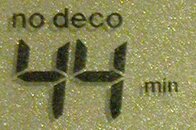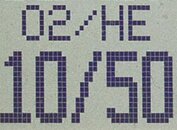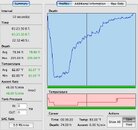Shearwater
Contributor
In response to a question in another thread, this is intended as a quick description of the difference between recreational and technical dive computers. It contains many simplifications in order to not lose the key points.
There are basically two hardware types and two functional types. Nothing fits exactly in to categories - Porsche makes SUVs for example. But the categories will help the description.
The hardware types might be described as graphical or character. The functional types might be described as recreational or technical.
But first, what do all dive computers do?
Dive Computers
Dive computers measure the pressure exerted on the diver by the water. They use some algorithm to calculate the amount of inert gas (nitrogen, helium) that is dissolved into the body of the diver.
This calculation is in some way based on the pressure of the water (ambient pressure) and the existing pressure of the inert gas in the diver (compartment or tissue pressure.)
The computer, at some short interval, continuously updates the inert gas dissolved.
At the same time, the computer periodically predicts the expected profile.
Note the two distinct operations. One is a hard calculation the dissolved gas. The second is a prediction the ascent.
In order to predict the ascent, the computer makes assumptions. For a recreational computer it is primarily the ascent rate. For a technical computer it also involves various partial pressures of oxygen (PPO2) as well as ascent rate.
The allowed ascent rate is based on the allowable excess of the dissolved gas in comparison to the ambient pressure (supersaturation) and in some cases, the way the gas comes out of solution is also considered (bubbles.)
Character computers
Character computers are typically designed for manufacturing. A huge part of the design process is creating a design that can be manufactured for a price that allows the manufacturer to make a reasonable margin, for the dealer to make a reasonable margin, and for the retail price to be in the range that divers are willing to pay. They also typically have to have very low power consumption to allow a reasonable battery life.
The sorts of decisions that are made based on these requirements are:
- Injection molded cases (expensive to build molds but cheap to build cases)
- Custom LCD (inexpensive but inflexible)
- LCD driver
- 8 bit processor to reduce power and costs
- Assembly programming to increase efficiency
At the bottom of the post on the left is a segment or character display. If you take a close look, you will notice that the display, including the titles, is made of pre-defined segments. These segments can be turned off and on, but they can not display anything that was not built into the design. These displays have two big advantages. The first is that they are very inexpensive in large quantities, and the second is that since they have a small number of picture elements, they are very simple to dive.
Battery life is typically at least a diving season, and is sometimes as long as five years.
Graphical computers
Graphic computers tend to be driven more by the task than the cost of manufacture. Since they only sell in the hundreds or few thousands, the volumes are not big enough to really get in to the economies of scale. The leading edge of technical computers is always moving, so new designs come out frequently from each manufacturer.
These sorts of decisions look more like this:
- Machined cases (easily changed but high unit costs)
- Graphical LCD (expensive but flexible)
- Data bus to display
- 16 or 32 bit processor with good floating point calculations
- High level languages, typically C, to cope with complexity
If you look at the display on the right below, it is made up of a dot matrix. The programmer can display characters or symbols as she chooses and is not limited by the display. The specification can change over time and the displayed information can change.
They are a more general purpose computer system than a designed-for-purpose appliance.
These more sophisticated displays and processors take quite a bit more power and the battery life could be measured in weeks or months.
Recreational Computers
The main characteristic that I would use to define a recreational computer is that it is not intended for staged decompression. They certainly have the logic to handle some decompression, but they are usually quite conservative once the diver has a decompression ceiling. Some, in fact, might give 10 times as much decompression time as a technical computer for a given dive.
The details of the decompression algorithm tend to be hidden, and features are described instead. The manufacturer might talk about adjustments for water temperature or exercise, rather than specific calculations.
Algorithmic efficiency is high on the list. Given the application, some short cuts can be taken that do not impact on no-deco diving, but make the system more efficient. An example would be only implementing a few of Buhlmanns 16 compartments.
The primary goal is to give the divers as much no-deco time as possible with the minimum number of injuries.
Technical Computers
Technical computers are intended for decompression. The manufacturer knows that customers will take them beyond, sometimes far beyond, recreational depths. They are intended for hours of staged decompression with multiple gases and contingency planning.
In order to sell, they tend to use published algorithms to allow the customers to intelligently evaluate their needs. Things like deep stops, gradient factors, and bubble models may be part of the customer requirements. The faithful implementation of known algorithms tends to be more important than secret adjustments.
Technical computers are intended to be used with multiple gases. They allow the user to program all of the gases on the dive and to switch gases as required. Most computers will actively predict the time to surface (TTS) based on all of the gases programmed or enabled, but there are some exceptions. Expected gas switches can be predicted by calculating the PPO2 of the gases carried. Most computers will not actually do the switch automatically though. They will wait for the diver to tell the computer the actual switch depth.
Most will have the capability to calculate profiles for open-circuit and closed-circuit dives. Some also work for semi-closed-circuit dives.
Most allow bail-out from closed circuit to open-circuit for rebreather divers. And finally, most allow for gases to be added or deleted during the dives to allow for contingencies.
All of these characteristics mean that the systems have to more complex and flexible.
The primary goal is to allow the customer to intelligently control the decompression risk as a part of the overall risk management of the dive.
I hope this has been useful.
Bruce Partridge
There are basically two hardware types and two functional types. Nothing fits exactly in to categories - Porsche makes SUVs for example. But the categories will help the description.
The hardware types might be described as graphical or character. The functional types might be described as recreational or technical.
But first, what do all dive computers do?
Dive Computers
Dive computers measure the pressure exerted on the diver by the water. They use some algorithm to calculate the amount of inert gas (nitrogen, helium) that is dissolved into the body of the diver.
This calculation is in some way based on the pressure of the water (ambient pressure) and the existing pressure of the inert gas in the diver (compartment or tissue pressure.)
The computer, at some short interval, continuously updates the inert gas dissolved.
At the same time, the computer periodically predicts the expected profile.
Note the two distinct operations. One is a hard calculation the dissolved gas. The second is a prediction the ascent.
In order to predict the ascent, the computer makes assumptions. For a recreational computer it is primarily the ascent rate. For a technical computer it also involves various partial pressures of oxygen (PPO2) as well as ascent rate.
The allowed ascent rate is based on the allowable excess of the dissolved gas in comparison to the ambient pressure (supersaturation) and in some cases, the way the gas comes out of solution is also considered (bubbles.)
Character computers
Character computers are typically designed for manufacturing. A huge part of the design process is creating a design that can be manufactured for a price that allows the manufacturer to make a reasonable margin, for the dealer to make a reasonable margin, and for the retail price to be in the range that divers are willing to pay. They also typically have to have very low power consumption to allow a reasonable battery life.
The sorts of decisions that are made based on these requirements are:
- Injection molded cases (expensive to build molds but cheap to build cases)
- Custom LCD (inexpensive but inflexible)
- LCD driver
- 8 bit processor to reduce power and costs
- Assembly programming to increase efficiency
At the bottom of the post on the left is a segment or character display. If you take a close look, you will notice that the display, including the titles, is made of pre-defined segments. These segments can be turned off and on, but they can not display anything that was not built into the design. These displays have two big advantages. The first is that they are very inexpensive in large quantities, and the second is that since they have a small number of picture elements, they are very simple to dive.
Battery life is typically at least a diving season, and is sometimes as long as five years.
Graphical computers
Graphic computers tend to be driven more by the task than the cost of manufacture. Since they only sell in the hundreds or few thousands, the volumes are not big enough to really get in to the economies of scale. The leading edge of technical computers is always moving, so new designs come out frequently from each manufacturer.
These sorts of decisions look more like this:
- Machined cases (easily changed but high unit costs)
- Graphical LCD (expensive but flexible)
- Data bus to display
- 16 or 32 bit processor with good floating point calculations
- High level languages, typically C, to cope with complexity
If you look at the display on the right below, it is made up of a dot matrix. The programmer can display characters or symbols as she chooses and is not limited by the display. The specification can change over time and the displayed information can change.
They are a more general purpose computer system than a designed-for-purpose appliance.
These more sophisticated displays and processors take quite a bit more power and the battery life could be measured in weeks or months.
Recreational Computers
The main characteristic that I would use to define a recreational computer is that it is not intended for staged decompression. They certainly have the logic to handle some decompression, but they are usually quite conservative once the diver has a decompression ceiling. Some, in fact, might give 10 times as much decompression time as a technical computer for a given dive.
The details of the decompression algorithm tend to be hidden, and features are described instead. The manufacturer might talk about adjustments for water temperature or exercise, rather than specific calculations.
Algorithmic efficiency is high on the list. Given the application, some short cuts can be taken that do not impact on no-deco diving, but make the system more efficient. An example would be only implementing a few of Buhlmanns 16 compartments.
The primary goal is to give the divers as much no-deco time as possible with the minimum number of injuries.
Technical Computers
Technical computers are intended for decompression. The manufacturer knows that customers will take them beyond, sometimes far beyond, recreational depths. They are intended for hours of staged decompression with multiple gases and contingency planning.
In order to sell, they tend to use published algorithms to allow the customers to intelligently evaluate their needs. Things like deep stops, gradient factors, and bubble models may be part of the customer requirements. The faithful implementation of known algorithms tends to be more important than secret adjustments.
Technical computers are intended to be used with multiple gases. They allow the user to program all of the gases on the dive and to switch gases as required. Most computers will actively predict the time to surface (TTS) based on all of the gases programmed or enabled, but there are some exceptions. Expected gas switches can be predicted by calculating the PPO2 of the gases carried. Most computers will not actually do the switch automatically though. They will wait for the diver to tell the computer the actual switch depth.
Most will have the capability to calculate profiles for open-circuit and closed-circuit dives. Some also work for semi-closed-circuit dives.
Most allow bail-out from closed circuit to open-circuit for rebreather divers. And finally, most allow for gases to be added or deleted during the dives to allow for contingencies.
All of these characteristics mean that the systems have to more complex and flexible.
The primary goal is to allow the customer to intelligently control the decompression risk as a part of the overall risk management of the dive.
I hope this has been useful.
Bruce Partridge






